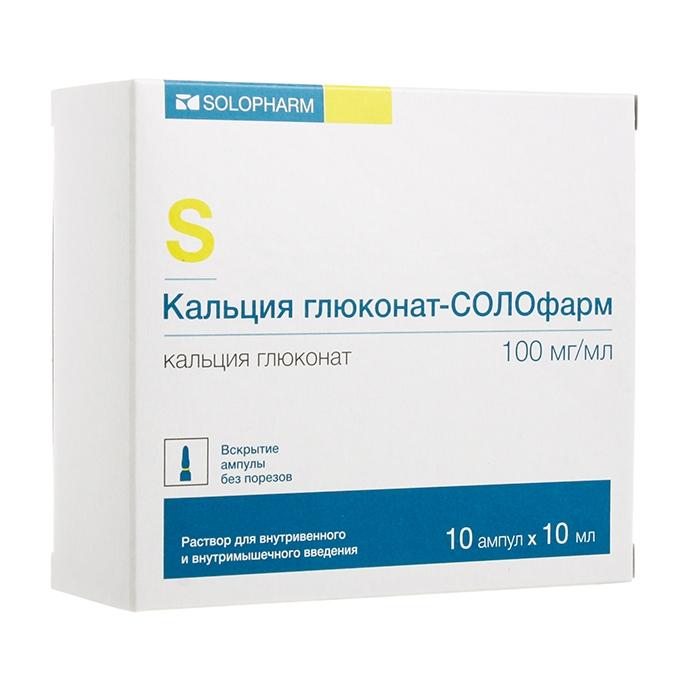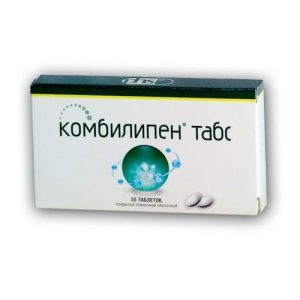Description
Release form
Solution for intravenous and intramuscular administration.
Pharmacological action
Pharmacotherapeutic group
Calcium-phosphorus metabolism regulator.
ATX Code: 12 03
Pharmacological properties of
Pharmacodynamics of
Calcium preparation fills the deficiency of calcium ions necessary for the transmission of nerve impulses, reduction of skeletal and smooth muscles, myocardial activity, bone formation, blood coagulation.
When administered intravenously, it stimulates the sympathetic part of the autonomic nervous system, enhances adrenaline secretion by the adrenal glands.
Pharmacokinetics
After parenteral administration of calcium, gluconate with blood flow is evenly distributed in all tissues and organs. In plasma, calcium is both in bound form (in complex with proteins and with anions of organic and inorganic acids (bicarbonate, phosphate, lactate, calcium citrate)), and in free ionized form.
Crosses the placental barrier, passes into breast milk. It is excreted mainly by the kidneys.
Indications
Treatment of acute hypocalcemia.
To reduce capillary permeability in allergic conditions, non-thrombocytopenic purpura, and exudative dermatoses, such as herpetiform dermatitis and pruritic rash due to the use of certain medications.
Contraindications
Hypersensitivity to calcium gluconate and other components of the drug, hypercalcemia (including in patients with hyperparathyroidism, hypervitaminosis D, decalcifying malignant neoplasms, renal failure, osteoporosis associated with immobilization, sarcoidosis, milk-alkaline syndrome (Burnett’s syndrome)), hypercalciuria, intoxication with cardiac glycosides, simultaneous treatment with cardiac glycosides for intramuscular administration.
Precautions
Dehydration, electrolyte disturbances (risk of developing hypercalcemia), diarrhea, malabsorption syndrome, calcium nephrourolithiasis (history), mild hypercalciuria, moderate chronic renal failure, common atherosclerosis, multiple coagulation, especially in patients the above conditions, nephrocalcinosis, pathology of the cardiovascular system, sarcoidosis, chronic heart failure, simultaneous treatment with epinephrine.
Before using the drug, consult your doctor.
Special instructions
The drug is heated to body temperature before administration. The drug is administered deeply intramuscularly or intravenously slowly (within 2-3 minutes), or drip, to exclude the possibility of local irritation or necrosis if the drug enters the perivascular tissue. Intravenous injections should be carried out under close monitoring of heart rate and electrocardiogram, because with too fast calcium gluconate administration, bradycardia with vasodilation and arrhythmias may occur.
With intravenous administration, a feeling of heat in the whole body is possible, which quickly passes.
Due to the risk of local irritation, intramuscular injections should only be given if intravenous injection is not possible. Intramuscular injections must be performed deep enough into the muscle, preferably into the gluteal region. For obese patients, a longer needle should be selected for safe insertion into the muscle rather than adipose tissue. If repeated injections are needed, the injection site should be changed each time.
During treatment, it is necessary to carefully monitor the concentration of calcium in the blood plasma, when administered in high doses – additionally control the rate of calcium excretion in urine.
With intravenous administration of calcium gluconate, in exceptional cases, patients receiving cardiac glycosides need monitoring of cardiac activity and conditions must be provided for the urgent treatment of cardiac complications (such as severe arrhythmias).
Calcium salts should be used with caution and only after carefully determining the indications in patients with nephrocalcinosis, pathology of the cardiovascular system, sarcoidosis (Beck’s disease), in patients receiving epinephrine, in elderly patients.
Impaired renal function may be associated with hypercalcemia and secondary hyperparathyroidism. Therefore, in patients with impaired renal function, parenteral administration of calcium should be prescribed only after a thorough determination of the indicators, and it is necessary to control the calcium-phosphate balance.
When used concomitantly with other drugs, medical supervision is required.
Use the solution only if it is clear and the ampoule is not damaged. Dilute the drug immediately after opening the ampoule. When diluting the drug, strict adherence to aseptic rules is required. In terms of microbiological safety, a diluted preparation should be used immediately. The ampoule is for single use only. The exception is breeding prepared under controlled aseptic conditions. After preparation of the solution, the terms and conditions of its storage until administration are the responsibility of the user and should be no more than 24 hours at a temperature of 2 to 8 ° C. The remaining unused volumes of the drug are subject to destruction.
Impact on the ability to drive transp. Wed and fur .:
During treatment with the drug, care must be taken when performing potentially hazardous activities that require an increased concentration of attention and speed of psychomotor reactions (driving, working with moving mechanisms, the work of the dispatcher and operator).
Composition
1 ml of the preparation contains:
Active ingredient:
Calcium gluconate monohydrate 94 mg
Excipients:
Calcium sugar 5 mg
Water for injection up to 1 ml
Dosage and administration of
Normally, the concentration of total calcium in the blood serum is 2.25-2.75 mmol / L or 4.45-5.5 sEq / L. Therapy with calcium gluconate is aimed at restoring the normal concentration of calcium in the blood plasma. Solutions containing calcium should be administered slowly in order to minimize peripheral vasodilation and inhibition of cardiac activity.
The drug is heated to body temperature before administration. The drug is administered deeply intramuscularly or intravenously slowly (within 2-3 minutes), or drip, to exclude the possibility of local irritation or necrosis if the drug enters the perivascular tissue. Intravenous injections should be carried out under close monitoring of heart rate and electrocardiogram, since bradycardia with vasodilation and arrhythmias can occur with too fast calcium gluconate administration.
With intravenous administration, a feeling of heat in the whole body is possible, which quickly passes.
Due to the risk of local irritation, intramuscular injections should only be given if intravenous injection is not possible. Intramuscular injections must be performed deep enough into the muscle, preferably into the gluteal region. For obese patients, a longer needle should be selected for safe insertion into the muscle rather than adipose tissue. If repeated injections are needed, the injection site should be changed each time.
During treatment, it is necessary to carefully monitor the concentration of calcium in the blood plasma, when administered in high doses – in addition to control the rate of calcium excretion in the urine.
Adults: deeply intramuscularly, slowly intravenously (within 2-3 minutes) or drip 5-10 ml of 100 mg / ml (10% solution) daily, every other day or after 2 days (depending on the nature of the disease and the clinical condition of the patient). Subsequent doses are determined in accordance with the concentration of calcium in the blood serum.
For children under 18 years: the dose and route of administration depend on the degree of development of hypocalcemia, the nature and severity of symptoms.
For children, depending on age, the drug at a concentration of 100 mg / ml (10% solution) is administered in the following doses: up to 6 months – 0.1-1 ml 7-12 months – 1-1.5 ml 1-3 years –
1.5-2 ml 4-6 years old – 2-2.5 ml 7-14 years old – 3.5 ml over 14 years old – doses for adults. Children can not enter the drug intramuscularly due to the possible development of necrosis. Only slow intravenous injection or intravenous infusion after dilution is recommended, in order to achieve sufficiently low rates of administration and to exclude the possibility of local irritation or necrosis in case of accidental ingestion of the drug into perivascular tissues.
For intravenous infusion, the drug is diluted 1:10 to a concentration of 10 mg / ml with the following infusion solutions: 0.9% sodium chloride solution or 5% glucose solution. The rate of intravenous administration should not exceed 50 mg of calcium gluconate per minute. Dilution should be carried out under aseptic conditions.
Elderly patients: There is no evidence of an adverse tolerance of calcium gluconate to elderly patients, but age-related changes, such as impaired renal function and a slowdown in metabolism, may require a dose reduction.
Procedure for working with a polymer vial:
– Take the vial and shake it, holding by the neck.
– Turn and separate the valve with rotary movements.
– Through the hole formed, immediately connect the syringe luer to the ampoule.
– Type the contents of an ampoule into a syringe.
– Put the needle on the syringe.
Side effects
The incidence of side effects is directly related to the rate of administration and the dose of calcium gluconate. With proper administration, the frequency of their occurrence is 1/1000.
From the cardiovascular system: lowering blood pressure, bradycardia, arrhythmia, vasodilation, circulatory collapse (including with a fatal outcome), hot flashes, most often with rapid administration.
From the digestive system: nausea, vomiting, diarrhea.
General disorders: sensation of heat, sweating.
Violations at the injection site: with intramuscular injection – pain or erythema (? 1/10,? 1/100), with a violation of the technique of intramuscular injection – infiltration into adipose tissue followed by the formation of an abscess, tissue tightening and necrosis with intravenous administration – skin hyperemia a burning sensation or pain with the possible development of tissue necrosis (with random perivascular injection).
A case of soft tissue calcification has been reported, followed by possible skin damage and necrosis due to the release of calcium from the vessel into the tissue.
Drug Interactions
A syringe filled with a calcium gluconate solution should not contain any residual ethyl alcohol, since gluconate precipitates in the presence of the latter calcium. Pharmaceutically incompatible with carbonates, salicylates, sulfates and ceftriaxone (forms insoluble or sparingly soluble calcium salts with them). Forms insoluble complexes with tetracycline antibiotics, reducing the antibacterial effect.
Reduces the effect of slow calcium channel blockers (intravenous administration of calcium gluconate before or after taking verapamil reduces its hypotensive effect, but has little effect on its antiarrhythmic effect).
When used simultaneously with quinidine, intraventricular conduction may be slowed and quinidine toxicity may increase.
The use of calcium gluconate is not recommended during treatment with cardiac glycosides (cardiotoxic effects of cardiac glycosides may be enhanced). When combined with thiazide diuretics, it can enhance hypercalcemia.
Reduces the effect of calcitonin in hypercalcemia.
Reduces the bioavailability of phenytoin.
Storage conditions
Store at a temperature not exceeding 25 ° C.
Keep out of the reach of children.
Expiration
3 years.
Deystvuyuschee substances
calcium gluconate



